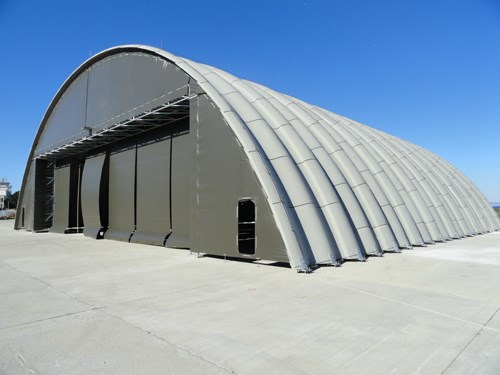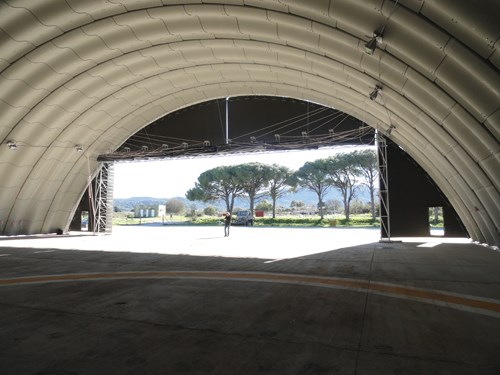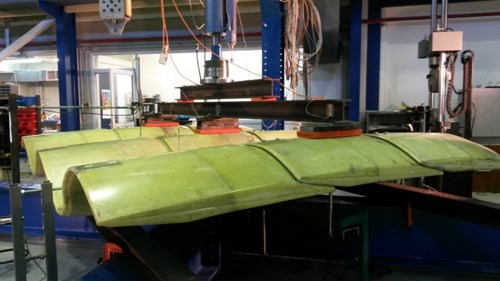Sandwich structure makes hangars possible
Greek company Dasyc has developed the high-strength Composite Modular Transportable Hangar (CMTH), which uses interlocked composite sandwich panels to ease assembly and disassembly.

Dasyc's Composite Modular Transportable Hangar uses a series of interlocked composite
sanwich panels to allow quick and easy assembly. The final structure features strength equal to that of a concrete or steel building and can be used for automotive, military, aerospace and a
variety of other end markets.
Hexcel's (Leicester, UK) HiMax glass fiber fabrics were selected by Dasyc SA (Athens, Greece) for the manufacture of its Composite Modular Transportable Hangar (CMTH). Constructed from prefabricated composite sandwich panels, this structure can be employed in a variety of civil or military applications. The use of Hexcel quadaxial reinforcements enabled Dasyc to manufacture a composite structure with a strength equivalent to that of a concrete or steel building.
Dasyc SA specializes in the processing of thermoplastics, bulk moulding compound and composites for the automotive, military, aerospace, electrical, and sports and leisure sectors. In 2010, the company launched CMTH to address a need for mobile storage, parking and housing structures. The patented design enables rapid transportation and assembly in any location. Disassembly is equally straightforward. The modules which make up the hangar can be stacked and stored in a limited space, and are designed for transport by truck, sea or air.
Possible applications for the hangars range from housing aircraft, helicopters and military vehicles, to the storage of equipment at construction sites or airports. Field hospitals, on-site office space and disaster relief/emergency response facilities are also possible. Composite sandwich panels are ideal for this application since they provide strength, stiffness and thermal insulation, as well as ease of manufacture and simplicity of assembly. The composite panels are lightweight, simplifying transportation and installation, and corrosion resistant, which results in minimal maintenance requirements. The installed structure also exhibits low infrared (IR) and radar signatures — key benefits for military applications.

Hangar interior.
Unlike permanent metal or concrete constructions, the composite structure can be moved and adapted to new requirements. The composite hangar has been tested and certified in cooperation with the National Technical University of Athens and is designed to withstand significant loads, offering a strength equivalent to that of traditional concrete or steel structures. Dasyc has already delivered three hangars to the Hellenic Air Force (HAF) and is now promoting the product internationally.
The composite panels are assembled together to form arches. Each arch is made up of a varying number of main panels (2.1m by 3.7 m), one half-size panel (1.15m by 3.7m) and two edge panels (which interface with the ground). All panels have the same radius of curvature (approximately 16.9m) and each arch is a geometric arc. The length of the arch can be adjusted by using a different number of main panels. The length of the hangar depends on the number of arches used – adding one arch increases the length by 3m.
For the hangars delivered to HAF, 10 arches (each constructed from 21 main panels) were used to give a hangar with a maximum height of 10.6m, a width of about 31m and a length of 30.7m. The panels are manufactured at Dasyc’s production plant in Markopoulo using vacuum-assisted resin transfer molding (VARTM). The 80-mm thick panels are sandwich structures consisting of a hard polyurethane (PU) core material (72 mm thick) between two laminate skins (each 4 mm thick) of glass fiber-reinforced polyester resin. In order to improve the stiffness of the construction, the panels are corrugated with a wave length of 1.5m and wave height of 380 mm.
For this project Dasyc required reinforcements that would form a composite structure with a strength similar to that of a concrete or steel, and capable of withstanding the same structural loads (wind load, snow load, working loads, etc.) as specified by the Eurocodes building regulations. To provide the required mechanical properties Hexcel Reinforcements UK (formerly Formax) supplied its FGE112 1200 g/m2 quadaxial fabric, consisting of four layers of E-glass fiberes aligned in the 0°/-45°/90°/+45° directions and stitched together with polyester thread. Four layers of FGE112 were used in each skin. In addition to imparting good structural support and stiffness to the laminate, quadaxial fabric is a cost-effective solution for reducing labor in the layup process as it is possible to apply multiple layers simultaneously. The isotropic properties exhibited by the quadaxial fabric also facilitated the development and analysis process for the hangar structure since it was easier to apply the standard building codes and gain customer acceptance.

Hangar assembly/installation.
To aid resin flow during molding, Hexcel supplied 450 g/m2 continuous filament mat. Approximately 40 tonnes of Hexcel glass fiber reinforcement was used in the hangars delivered to HAF. To validate the performance of the composite panels Dasyc conducted extensive testing. This included tests on standardized samples and small-scale panels, and finished with bending tests on assembled panels.
The outer surface of the panels is coated with an ISONPG gel coat (available in a number of colors), which provides good weather resistance. The hangars can be installed using standard tools and a crane. Panels are assembled with the use of screws andbolts, and elastic gaskets are used to seal the joints. Installation does not require any special subterranean preparation. Only two strips of concrete are needed for the footprint of the arches. The arches are anchored to these using metallic anchor plates. The first arch is assembled on the ground, erected using a crane and bolted on to the anchors. The remaining arches are assembled in groups of three to six panels, which are placed in position using the previously erected arch as a guide.
Total assembly (and disassembly) time is less than two weeks for a standard-size hangar, although actual assembly time depends on the available workforce. Various options are available, enabling the customer to customize the hangar to their requirements. These include covers for the open sides of the hangar, electrical installation, a lightning protection system, and installation of photovoltaic panels. Dasyc can undertake the transportation, assembly and disassembly of the hangar at the customer’s designated site and will train the customer in all these aspects.
Dasyc is currently working on a redesign of CMTH to exploit the anisotropic properties of composite materials. The current use of quadaxial fabric leads to an isotropic composite structure exhibiting the same strength in the 0°, -45°, 90° and +45° directions. However, there is a non-uniform distribution of the stresses on the hangar structure, with more than 70% of the stresses concentrated in the 0° direction. The new laminate lay-up will employ unidirectional (UD) fabrics to strengthen this direction and eliminate unnecessary reinforcement from the other directions. Hexcel is working with Dasyc to trial a combination of UD, quadaxial and triaxial fabrics, enabling the structure’s mechanical performance to be optimized in the required directions. In June 2016 Dasyc received samples of Hexcel fabrics to start production of samples for verification of the optimized lay-up. Production is scheduled to resume in October.

Composite sandwich panels being tested.
Dasyc is also improving its mold construction in order to enhance resin flow during the VARTM process. In studies, the new fabric lay-up has also shown improved flow patterns. To further aid flow Dasyc and Hexcel will investigate the use of high-drape fabrics and a quadaxial fabric with integrated chopped strand mat (CSM) layer to enhance flow and surface finish. “We are very happy with our cooperation with Hexcel on this project,” says Nikos Efentakis President & Managing Director of Dasyc SA. “Hexcel offered us the quality we expect, together with competitive pricing and a professional collaborative framework.”
Related Content
Manufacturing the MFFD thermoplastic composite fuselage
Demonstrator’s upper, lower shells and assembly prove materials and new processes for lighter, cheaper and more sustainable high-rate future aircraft.
Read MorePEEK vs. PEKK vs. PAEK and continuous compression molding
Suppliers of thermoplastics and carbon fiber chime in regarding PEEK vs. PEKK, and now PAEK, as well as in-situ consolidation — the supply chain for thermoplastic tape composites continues to evolve.
Read MoreA new era for ceramic matrix composites
CMC is expanding, with new fiber production in Europe, faster processes and higher temperature materials enabling applications for industry, hypersonics and New Space.
Read MoreJeep all-composite roof receivers achieve steel performance at low mass
Ultrashort carbon fiber/PPA replaces steel on rooftop brackets to hold Jeep soft tops, hardtops.
Read MoreRead Next
Developing bonded composite repair for ships, offshore units
Bureau Veritas and industry partners issue guidelines and pave the way for certification via StrengthBond Offshore project.
Read More“Structured air” TPS safeguards composite structures
Powered by an 85% air/15% pure polyimide aerogel, Blueshift’s novel material system protects structures during transient thermal events from -200°C to beyond 2400°C for rockets, battery boxes and more.
Read MoreVIDEO: High-volume processing for fiberglass components
Cannon Ergos, a company specializing in high-ton presses and equipment for composites fabrication and plastics processing, displayed automotive and industrial components at CAMX 2024.
Read More






















